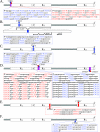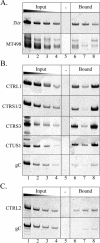A chromatin insulator-like element in the herpes simplex virus type 1 latency-associated transcript region binds CCCTC-binding factor and displays enhancer-blocking and silencing activities
- PMID: 16474142
- PMCID: PMC1395413
- DOI: 10.1128/JVI.80.5.2358-2368.2006
A chromatin insulator-like element in the herpes simplex virus type 1 latency-associated transcript region binds CCCTC-binding factor and displays enhancer-blocking and silencing activities
Abstract
A previous study demonstrated that the latency-associated transcript (LAT) promoter and the LAT enhancer/reactivation critical region (rcr) are enriched in acetyl histone H3 (K9, K14) during herpes simplex virus type 1 (HSV-1) latency, whereas all lytic genes analyzed (ICP0, UL54, ICP4, and DNA polymerase) are not (N. J. Kubat, R. K. Tran, P. McAnany, and D. C. Bloom, J. Virol. 78:1139-1149, 2004). This suggests that the HSV-1 latent genome is organized into histone H3 (K9, K14) hyperacetylated and hypoacetylated regions corresponding to transcriptionally permissive and transcriptionally repressed chromatin domains, respectively. Such an organization implies that chromatin insulators, similar to those of cellular chromosomes, may separate distinct transcriptional domains of the HSV-1 latent genome. In the present study, we sought to identify cis elements that could partition the HSV-1 genome into distinct chromatin domains. Sequence analysis coupled with chromatin immunoprecipitation and luciferase reporter assays revealed that (i) the long and short repeats and the unique-short region of the HSV-1 genome contain clustered CTCF (CCCTC-binding factor) motifs, (ii) CTCF motif clusters similar to those in HSV-1 are conserved in other alphaherpesviruses, (iii) CTCF binds to these motifs on latent HSV-1 genomes in vivo, and (iv) a 1.5-kb region containing the CTCF motif cluster in the LAT region possesses insulator activities, specifically, enhancer blocking and silencing. The finding that CTCF, a cellular protein associated with chromatin insulators, binds to motifs on the latent genome and insulates the LAT enhancer suggests that CTCF may facilitate the formation of distinct chromatin boundaries during herpesvirus latency.
Figures






References
-
- Bell, A. C., A. G. West, and G. Felsenfeld. 1999. The protein CTCF is required for the enhancer blocking activity of vertebrate insulators. Cell 98:387-396. - PubMed
-
- Burcin, M., R. Arnold, M. Lutz, B. Kaiser, D. Runge, F. Lottspeich, G. N. Filippova, V. V. Lobanenkov, and R. Renkawitz. 1997. Negative protein 1, which is required for function of the chicken lysozyme gene silencer in conjunction with hormone receptors, is identical to the multivalent zinc finger repressor CTCF. Mol. Cell. Biol. 17:1281-1288. - PMC - PubMed
-
- Capelson, M., and V. G. Corces. 2004. Boundary elements and nuclear organization. Biol. Cell 96:617-629. - PubMed
Publication types
MeSH terms
Substances
Grants and funding
LinkOut - more resources
Full Text Sources
Other Literature Sources
Research Materials

